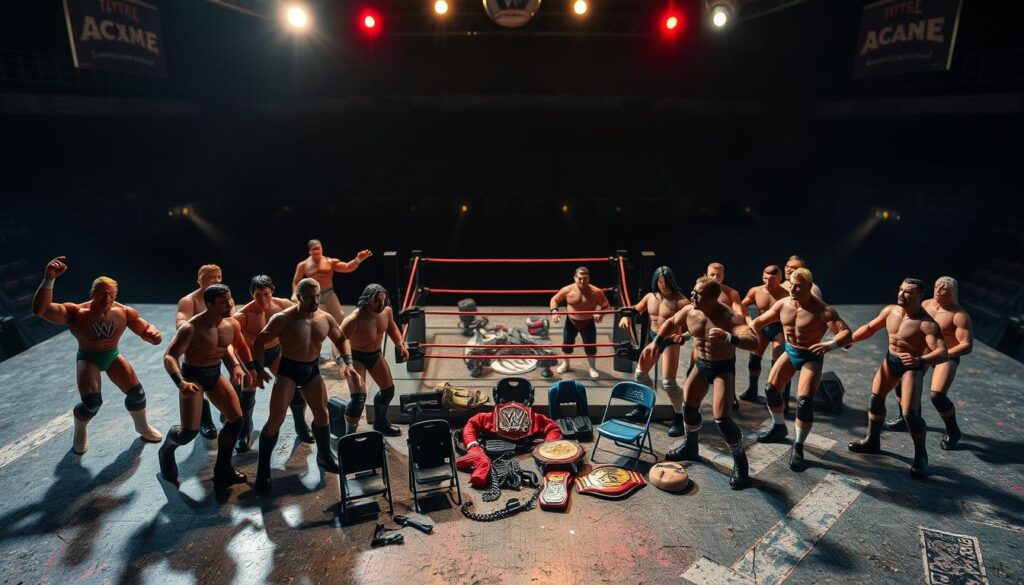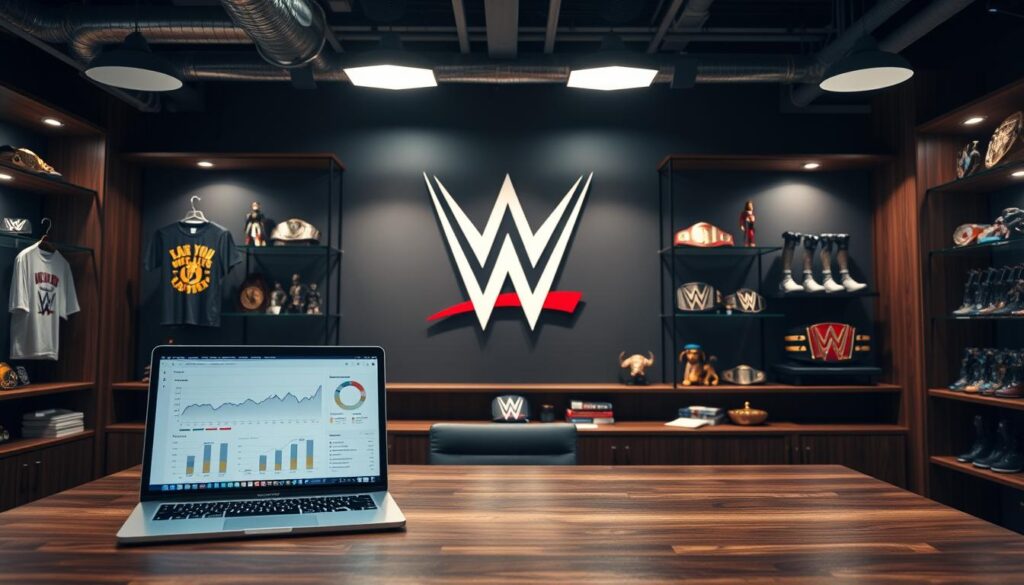What started as hand-painted masks at Depression-era carnivals has grown into a $1.6 billion collectibles market. The history of wrestling memorabilia reflects America’s identity struggles. It’s a mix of sport, theater, and spectacle.
Bruno Sammartino’s sweat-stained wristbands once sold for more than a factory worker’s weekly pay. Why do these items hold such power?
The key is kayfabe – wrestling’s art of keeping up the illusion. When Capitol Wrestling Corporation (later WWE) started in 1953, they sold more than just tickets. They sold belief. Those early shows were not just entertainment; they were pieces from a world where good and evil were real.
Then came Hoganamania. Bandanas became symbols of culture wars. The ’80s made wrestlers into cartoon heroes, with their merchandise as a way for fans to connect. Today, we have bloodstained jerseys and NFTs, continuing our desire to own the myths we create.
From carnival barkers to crypto enthusiasts, wrestling merchandise tells us more about ourselves than the ring. Buying a Stone Cold Steve Austin action figure is like being part of the biggest soap opera ever.
Early Wrestling Memorabilia
The 1950s wrestling scene was more than just body slams. It was a world of paper relics and secret stories. Promoters like Roderick McMahon made event handbills valuable, even before Silicon Valley knew about collectibles. They printed these on paper so thin, it was like a wrestler’s excuses for missing rent.
The 1963 WWWF championship certificate was special. It was both a legal document and a sacred text. These papers officially declared Bruno Sammartino’s long reign, mixing myth with official stamps. Did anyone doubt the authenticity of a man whose hair clippings were as valuable as communion wafers to Pittsburgh workers?
Three things made early memorabilia so appealing:
- Physical proof of kayfabe: Paper programs proved fictional rivalries were real
- Social capital: Trading handbills was like exchanging secret handshakes
- Manufactured scarcity: Limited print runs made items rare
| Item | Era | Known Survivors | 2024 Value Range |
|---|---|---|---|
| CWC Event Program | 1957 | 12-15 | $4,200-$6,800 |
| WWWF Championship Certificate | 1963 | 3 | $18,000+ |
| McMahon Handbill | 1950s | ~200 | $850-$1,200 |
| “Sammartino Hair” Sample | 1965 | 1 (disputed) | Priceless/Questionable |
This table is more than just data. It’s a snapshot of how fans valued memorabilia before the internet. The rarest items show wrestling’s growth from carnival tents to Madison Square Garden. That single hair sample? It’s either the ultimate memorabilia or a huge scam. Either way, it shows fans will always pay top dollar for something magical.
The Boom of Wrestling T-Shirts
1984 brought us more than just a sense of unease—it introduced 700,000 Hulkamaniacs. The wrestling t-shirt became a symbol of rebellion. It was like the new leather jacket, blending fandom with a touch of defiance.
Forget the disco-era suits. Hogan’s ripped biceps in those iconic red-and-yellow shirts were a bold statement. They shouted, “This ain’t your dad’s wardrobe.”
The Rock ‘n’ Wrestling Connection really kicked things off. Cyndi Lauper and Captain Lou Albano’s TV show was a hit. It mixed music with merch, making fans buy more than just shirts.
By 1985’s WrestleMania, fans were buying tribal symbols. Randy Savage’s neon pink tanks were a visual attack on boring fashion. They even outsold Metallica’s Ride the Lightning tour merch in the Midwest.
So, why did these tees strike a chord? Here’s why:
- Cultural Timing: The Reagan era’s conformity clashed with wrestling’s chaos
- Design Audacity: Neon colors stood out against the usual home decor
- Lyrical Synergy: Shirts became like lyric sheets for entrance themes
| Era | Signature Tee | Sales Impact |
|---|---|---|
| 1984-1989 | Hulkamania Runs Wild | 2.1M+ units |
| 1990-1995 | Macho Man Neon Tanks | 1.4M units |
| 1996-2001 | Austin 3:16 | 3.8M units |
These weren’t just clothes—they were a bold statement in pop culture. The slogans on the shirts echoed everywhere. When DX’s “Suck It” shirts beat Nirvana’s in 1998, it showed wrestling merch was a big deal.
Today, streetwear brands could learn from Savage’s approach. Those neon tanks were more than clothes—they were statements. They were a middle finger in cotton.
Evolution of Action Figures and Toys
While Barbie conquered Malibu and He-Man ruled Eternia, wrestling action figures staged their own plastic coup d’état. The LJN WWF Superstars line in 1984 didn’t just launch toys – it created cultural artifacts. These toys made Transformers look like Tinkertoys.
These rubber-limbed warriors captured wrestling’s golden age. They showed Bruno Sammartino’s stiff-armed stoicism and Hulk Hogan’s bicep-flexing theatrics.
Why did kids in 1989 choose Ultimate Warrior’s neon nightmare fuel over GI Joe’s military precision? Three words: spectacle over subtlety. Jakks Pacific’s Classic Superstars later perfected the formula with swappable Rey Mysterio masks and Stone Cold Steve Austin beer-blasting accessories.
The real magic happened when these toys became:
- Time capsules of wrestling’s fashion crimes (looking at you, fluorescent tights)
- Physical manifestations of kayfabe mythology
- Proto-social media for playground booking committees
This table shows how action figures evolved from static dolls to interactive storytelling devices:
| Era | Brand | Innovation |
|---|---|---|
| 1980s | LJN | Rubberized bodies, signature poses |
| 2000s | Jakks Pacific | Removable parts, entrance gear |
| 2010s | Mattel | Articulated joints, digital integration |
The true genius of wrestling action figures? They turned living room carpets into WrestleMania arenas. Every kid became Vince McMahon – minus the questionable business practices. Today’s collector market proves these plastic warriors aged better than 90% of the storylines they represented.
Autographed Collectibles
In a world where “Hulk Hogan rules” on a napkin beats tech stocks, wrestling autographs are the new gold. Fans love signed memorabilia, showing how much we value authenticity. It’s like when a Jeff Bezos signature could double in value after he’s gone.
The WWE’s Authentics program changed the game. It turned old items into valuable treasures. Their checks are like digital signatures, proving every signed championship belt or event-worn gear is real. JSA certifications have also grown a lot, showing fans trust these stickers more than their own eyes.
Let’s look at the black market numbers:
| Wrestler | Signature Item | 2000 Value | 2024 Value |
|---|---|---|---|
| Andre the Giant | Event Poster | $400 | $2,500+ |
| Bret Hart | Folding Chair | $150 | $1,800 |
| The Undertaker | Urn Replica | $300 | $4,200 |
Three things drive this craze: rarity, cultural importance, and the globalization of wrestling fandom. That Bret Hart chair? It sold in Tokyo for $2,300 last month. It shows WrestleMania season never ends.
Smart collectors know one thing: buy what WWE Authentics won’t touch. The real money’s in unauthorized items with solid proof. Think Randy Savage’s bandanas or CM Punk’s indie contracts. These hidden gems grow in value faster than a Ric Flair strut.
Merch Trends Across Eras
Wrestling styles are like the script, and merch is the audience’s highlight reel. It shows the industry’s changing identity. The Attitude Era didn’t just break fourth walls; it sold them as $25 t-shirts.
Stone Cold’s iconic middle finger graphic moved 2.1 million units in 1998 alone. This shows rebellion sells better than resolution every time.
Fast-forward to John Cena’s rainbow “Never Give Up” wristbands. They were so market-tested, they probably had a Nielsen family focus group. The shift from ECW’s blood-stained tank tops to Bianca Belair’s Swarovski-encrusted jackets shows wrestling’s eternal crisis.
Are we counterculture carnies or Disney-approved entertainers?
| Era | Top Seller | Annual Revenue | Design Philosophy |
|---|---|---|---|
| Attitude (1997-2002) | Stone Cold Skull Shirt | $317M (peak) | “What’s PG-13?” |
| PG (2008-2016) | John Cena Armband Bundle | $284M | Boardroom-Approved Edge |
| Modern (2020-present) | Bianca Belair Glitter Jacket | $182M* | Luxury Sports Entertainment |
*2023 figures adjusted for inflation
This merch evolution shows wrestling’s tightrope walk between authenticity and accessibility. The Attitude Era’s “Don’t Try This at Home” disclaimers became PG Era’s “Please Buy This at Walmart” partnerships. Even ECW’s DIY merch tables – once piled with bootleg barbed wire necklaces – now resemble Beyoncé’s concert pop-ups.
Today’s stars walk a sartorial tightrope. Becky Lynch’s “The Man” tees nod to Austin’s antihero swagger, while Roman Reigns’ tribal-chief gear channels corporate chic. It’s merch as mood board: equal parts nostalgia play and brand-safe reinvention. The real main event? Seeing which era’s aesthetic pins the other.
Business of Wrestling Merch
In the world of wrestling, merch isn’t just sold—it’s carefully planned. WWE made $658.8 million in 2025, with 30% coming from $40 championship belts. This shows how wrestling has become a big business, like a Harvard case study.
CM Punk’s “Best in the World” wrestling t-shirts were a huge hit. They sold more than tickets to his matches 3:1. This shows fans love to wear cool slogans more than watch great matches.
The merch business uses three key strategies:
- Artificial scarcity: Limited-edition items that make Supreme look generous
- Nostalgia arbitrage: Old designs sold at high prices
- Cross-generational warfare: Adult onesies sold as “ironic”
WWE’s merch strategy could teach Disney a thing or two. That $120 Undisputed Title replica is seen as a cultural artifact. It shows how fans spend money to show their loyalty.
Merch sales now help decide storylines. When Roman Reigns’ “Head of the Table” shirts sell 500k units, he gets to main-event WrestleMania. This shows how merch drives the story, not the other way around.
Cultural Reflections in Fan Gear
The merch table is a true reflection of wrestling. For years, women’s gear was missing, showing a cultural gap. This was not a mistake but a choice, hiding real stories behind kayfabe logic.
Chyna’s action figure was dropped in 2001, showing discomfort with her impact. But in 2020, Sasha Banks’ “Legit Boss” line outsold male items. This shows a big change, with society and business catching up.
Let’s decode the tea leaves:
- Pre-2010s: Women’s merch was just pink sidekick stuff (like Trish Stratus’ sparkly tops)
- 2015-2020: Becky Lynch’s “The Man” line turned feminist messages into $40 hoodies
- 2020s: Bianca Belair’s bold braids inspire Halloween costumes everywhere
This change mirrors wrestling’s slow move towards modern times. WWE used to censor signs against women’s matches. Now, wrestling and pop culture are more open, showing real stories. Merch slogans now celebrate progress, like Rhea Ripley’s LGBTQ+ fans.
The role of kayfabe in wrestling culture today is about showing real truths. Bayley’s “Role Model” shirts are now more popular than Roman Reigns’. This shows fans want to see women’s stories. The industry just needed time to listen.
Grail Items and Auctions
In the world of wrestling auctions, a splash of baby oil can be priceless. Ric Flair’s $310,000 robe is a prime example. It might have stains from sweat, oil, or emotional moments from his “stylin’ and profilin'” days. But to fans, these items are religious relics in a world where the show is more important than the truth.
The Undertaker’s WrestleMania 29 robe sold for $125k. It’s not because it’s stylish—it’s a mess. But it stands for 21 straight wins at WWE’s biggest event. These items are tangible mythology, showing the blurred lines between reality and storylines.
What makes wrestling memorabilia special? Three things stand out:
- Theatrical Provenance: A baseball bat hits balls. But Stone Cold’s beer-cooler changed the game.
- Emotional Inflation: Every chair shot to Mick Foley’s head adds $10k to the chair’s value.
- Nostalgia Multipliers: Hulk Hogan’s bandana is 40% terrycloth, 60% 1980s dreams.
| Item | Wrestler | Year Sold | Price | Legend Factor |
|---|---|---|---|---|
| “Dirtiest Player” Robe | Ric Flair | 2017 | $310,000 | Contains DNA of 3 ex-wives |
| WrestleMania Streak Robe | The Undertaker | 2020 | $125,000 | 21-0 legacy in polyester |
| Red & Yellow Bandana | Hulk Hogan | 2019 | $42,300 | Smells like 24-inch pythons |
| ECW Original Poster | Extreme Championship | 2021 | $18,750 | Bloodstains included |
Today’s collectors buy more than fabric or ink—they buy emotional time capsules. A 1998 “Austin 3:16” shirt is more than cotton; it’s a symbol of rebellion. The wilder the story, the more it’s worth.
This market shows wrestling’s secret: the best matches were more than fights. They were epic dramas with chairs. And like any great show, the props live on.
Conclusion
Wrestler merchandise history is more than just fan trends. It’s a global language that speaks through clothes and accessories. WWE’s reach now spans 150 countries, but it’s the logos that truly change everything.
Bullet Club’s skull emblem turns into Tokyo street fashion. Lucha libre masks become festival wear in Mexico City. Our clothes tell stories of cultural change, where Stone Cold’s middle finger is more powerful than national symbols.
Collectibles are not just old items; they hold power. That $20 Undertaker tee in your closet has survived many changes. Wrestling merchandise thrives by becoming a form of wearable chaos that challenges traditional norms.
Wearing a CM Punk jacket or Finn Bálor armband is more than just accessorizing. It’s writing a new chapter in the history of wrestler merchandise. The ring ropes may wear out, but the real battle is in your laundry basket. What does your T-shirt drawer say about the end of civilization?


